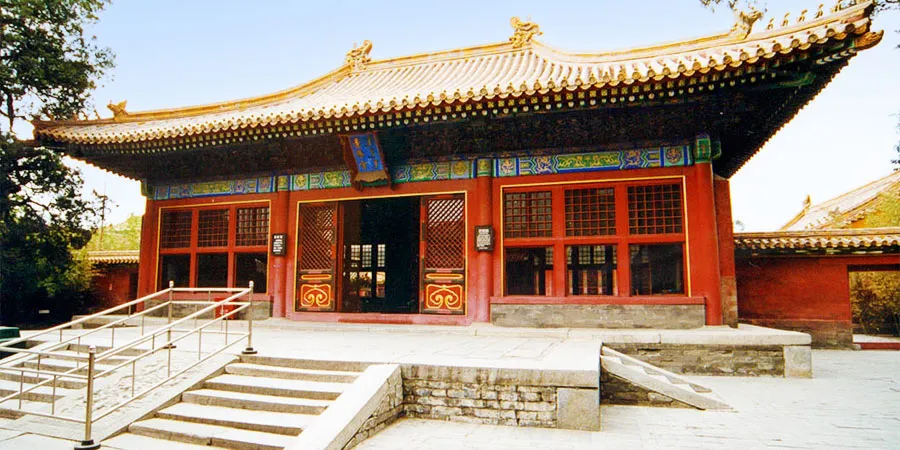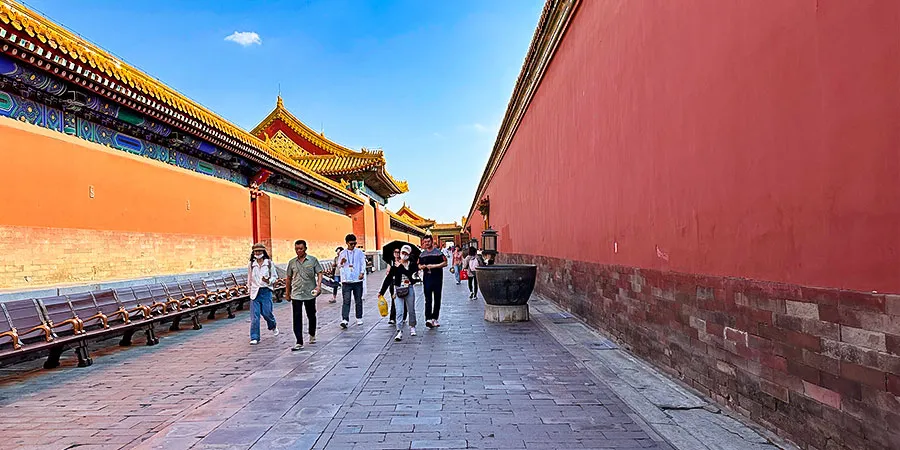Palace of Great Brilliance (Jingyanggong)
The Palace of Great Brilliance is one of the Six Eastern Palaces in the Forbidden City, east of the Palace of Accumulated Purity and north of the Palace of Eternal Harmony. Built in 1420, it first functioned as a residence for emperor's concubines, and then a storage of calligraphy and painting till 1924.
The area of Great Brilliance Palace encompasses two courtyards. The front one, accessed through its south Gate of Great Brilliance, features the main hall named Palace of Great Brilliance and adorned with mythical creatures on its eaves, with three halls on both sides. Moving to the backyard, there is the Imperial Books Repository as the key structure and a well in the southwest corner.
This palace had served for imperial concubines' living from 1420 to early 18th century.
It is worth noting that in terms of location, it occupies the northeastern part of the Six Eastern Palaces, which is considered the most prosperous position in Chinese metaphysics theory. But ironically, it was known as the "Cold Palace", a neglected place where disfavored imperial concubines lived. This inauspicious nickname originated from Consort Gong's (1565~1611) tragic life experience in the Palace of Great brilliance.
In 1581, Emperor Wanli (1573~1620) impulsively bedded Wang, a maid in his mother Empress Dowager Li's (1546~1614) palace. When Wang later became pregnant, the status-conscious emperor initially denied responsibility—until the Dowager produced official records of his visits. Forced to acknowledge the truth, he grudgingly granted Wang the title "Consort Gong".
Gong's son Zhu Changluo, born in 1582 as the emperor's firstborn, should have been named crown prince by tradition. But Wanli, infatuated with Consort Zheng, schemed to make Zheng's son the heir instead.
The Dowager's intervention finally secured Changluo's princely title in 1601, but at cruel cost—the boy was taken from Gong's arms to be raised by the Dowager, while she was confined to the Palace of Great Brilliance like a criminal. There, under Consort Zheng's orders, servants withheld her drinking water and winter coal. What's worse, the perpetual weeping stole her sight.
In 1611, as Gong lay dying, her son knelt for hours before being allowed one final visit. When he rushed to her bedside, the blind concubine could only clutch his robes, murmuring through tears: "To see you grown… now I may die without regret.", and finally, passed away that night.
Gong's suffering made the Palace of great Brilliance consider as the "Cold Palace" in the followed years. When the Qing took the Forbidden City in 1644, they kept this palace as quarters for low-ranking concubines. Records showed that in 1707, 129 of the lowest-tier imperial consorts crammed within its walls.
During mid-18th century, Emperor Qianlong transformed the Palace of Great Brilliance into a repository for calligraphy and paintings. The role retained until Puyi (1906~1967), the last emperor, departed the Forbidden City in 1924.
Among the paintings stored in the palace were twelve Palace Instruction Paintings, which were commissioned by Emperor Qianlong to depict moral examples of ancient Chinese imperial consorts. They were displayed in the Six Eastern and Western Palaces during important festivals as guidance for the imperial household.
The painting dedicated to the Palace of Great Brilliance is the Empress Ma in Plain Garments, emphasizing the virtue of frugality. In the painting, Empress Ma (40~79AD), despite her high status, wears unadorned, plain white clothing. She once said, "I lead by example in humble attire, reject opulence, and encourage my attendants to do so. My mission is to foster frugality, standing as a bulwark against the wastefulness that could bring our dynasty to ruin."
 |
| Palace of Great Brilliance |
Layout
The area of Great Brilliance Palace encompasses two courtyards. The front one, accessed through its south Gate of Great Brilliance, features the main hall named Palace of Great Brilliance and adorned with mythical creatures on its eaves, with three halls on both sides. Moving to the backyard, there is the Imperial Books Repository as the key structure and a well in the southwest corner.
What was the Palace of Great Brilliance used for?
Residence of Concubines, Nickname "Cold Palace"
This palace had served for imperial concubines' living from 1420 to early 18th century.
It is worth noting that in terms of location, it occupies the northeastern part of the Six Eastern Palaces, which is considered the most prosperous position in Chinese metaphysics theory. But ironically, it was known as the "Cold Palace", a neglected place where disfavored imperial concubines lived. This inauspicious nickname originated from Consort Gong's (1565~1611) tragic life experience in the Palace of Great brilliance.
In 1581, Emperor Wanli (1573~1620) impulsively bedded Wang, a maid in his mother Empress Dowager Li's (1546~1614) palace. When Wang later became pregnant, the status-conscious emperor initially denied responsibility—until the Dowager produced official records of his visits. Forced to acknowledge the truth, he grudgingly granted Wang the title "Consort Gong".
Gong's son Zhu Changluo, born in 1582 as the emperor's firstborn, should have been named crown prince by tradition. But Wanli, infatuated with Consort Zheng, schemed to make Zheng's son the heir instead.
 |
| Six Eastern Palaces Area |
The Dowager's intervention finally secured Changluo's princely title in 1601, but at cruel cost—the boy was taken from Gong's arms to be raised by the Dowager, while she was confined to the Palace of Great Brilliance like a criminal. There, under Consort Zheng's orders, servants withheld her drinking water and winter coal. What's worse, the perpetual weeping stole her sight.
In 1611, as Gong lay dying, her son knelt for hours before being allowed one final visit. When he rushed to her bedside, the blind concubine could only clutch his robes, murmuring through tears: "To see you grown… now I may die without regret.", and finally, passed away that night.
Gong's suffering made the Palace of great Brilliance consider as the "Cold Palace" in the followed years. When the Qing took the Forbidden City in 1644, they kept this palace as quarters for low-ranking concubines. Records showed that in 1707, 129 of the lowest-tier imperial consorts crammed within its walls.
Calligraphy & Painting Repository
During mid-18th century, Emperor Qianlong transformed the Palace of Great Brilliance into a repository for calligraphy and paintings. The role retained until Puyi (1906~1967), the last emperor, departed the Forbidden City in 1924.
Among the paintings stored in the palace were twelve Palace Instruction Paintings, which were commissioned by Emperor Qianlong to depict moral examples of ancient Chinese imperial consorts. They were displayed in the Six Eastern and Western Palaces during important festivals as guidance for the imperial household.
The painting dedicated to the Palace of Great Brilliance is the Empress Ma in Plain Garments, emphasizing the virtue of frugality. In the painting, Empress Ma (40~79AD), despite her high status, wears unadorned, plain white clothing. She once said, "I lead by example in humble attire, reject opulence, and encourage my attendants to do so. My mission is to foster frugality, standing as a bulwark against the wastefulness that could bring our dynasty to ruin."
See more Six Eastern Palaces
- Last updated on Oct. 15, 2025 by Jally Zhang -